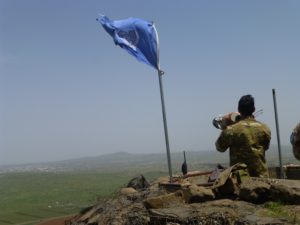
Now that President Bashar Assad regained control of the Syrian Golan Heights, Jerusalem asks U.N. to increase size of UNDOF force from 1,000 to 1200-1300 peacekeepers.
• Remember: UNDOF retreated from Syria in 2014 after peacekeepers were kidnapped by an al Qaida force.
By Lilach Shoval
Israel has asked the United Nations to reinstate its Disengagement Observer Force on the Syrian side of the Golan Heights border, outgoing Northern Command Chief of Staff Brig. Gen. Asher Ben-Lulu has confirmed to Israel Hayom.
UNDOF peacekeepers were first deployed on both sides of the Golan Heights border in 1974 as part of the Separation of Forces Agreement between Israel and Syria after the 1973 Yom Kippur War. Under the agreement, UNDOF is the only force authorized to be in the buffer zone, and its role is to monitor the military presence of both sides near the border.
However, UNDOF abandoned two-thirds of its border positions on the Syrian side four years ago, after 45 Fijian peacekeepers were kidnapped by members of the al Qaida-affiliated Nusra Front. Seventy-two other Filipino UNDOF troops were trapped but managed to escape.

Filipino UNDOF troops seeking protection in Israel.
Ever since the withdrawal, UNDOF troops have largely been stationed on the Israeli side of the Golan Heights border, where they report to the U.N. on the movement of IDF forces. One small UNDOF stronghold stayed in territory that remained under Syrian President Bashar Assad’s control.
With Assad’s forces having regained control of the Syrian Golan Heights, Israel wants UNDOF to return to the Syrian side of the border. To this end, Israel has asked the United Nations to increase the number of troops in the region from 1,000 to between 1,200 and 1,300.
Israel is also looking to open the Quneitra border crossing from time to time.
While Syria and Israel do not maintain diplomatic ties, the Druze population in the Israeli Golan Heights has been able to transport its apple harvest to the Syrian market with the assistance of the International Committee of the Red Cross. Apple-growing is the chief livelihood for the Druze residents of the Golan Heights.
In the past, many Druze students crossed the border to attend college in Damascus, a practice that ended in 2012 as a result of the civil war.
While Jerusalem authorized the transport of apples across the border in an effort to help the Druze population reduce its surplus produce, Damascus did so in an effort to demonstrate it still retains sovereignty over the Israeli side of the Golan Heights and the 20,000-strong Druze population living there.
View original Israel Hayom publication at:
http://www.israelhayom.com/2018/08/22/as-assad-retakes-ground-israel-asks-un-to-restore-forces-to-syria-border/






 Israeli New Shekel Exchange Rate
Israeli New Shekel Exchange Rate